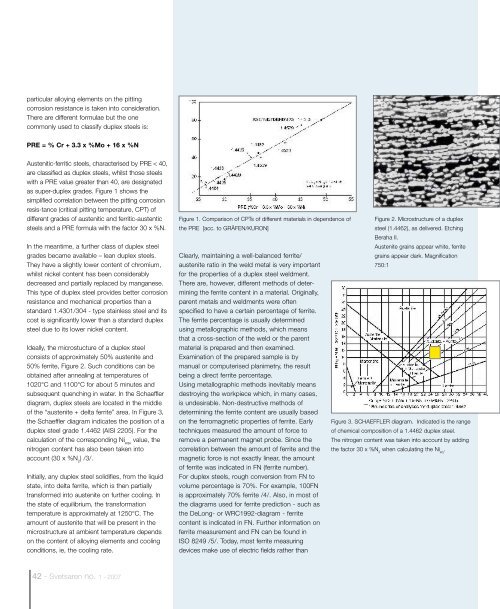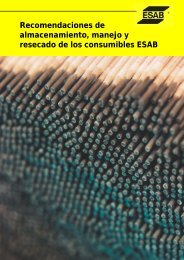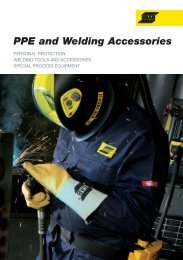Create successful ePaper yourself
Turn your PDF publications into a flip-book with our unique Google optimized e-Paper software.
particular alloying elements on the pitting<br />
corrosion resistance is taken into consideration.<br />
There are different formulae but the one<br />
commonly used to classify duplex steels is:<br />
PRE = % Cr + 3.3 x %Mo + 16 x %N<br />
Austenitic-ferritic steels, characterised by PRE 40,<br />
are classified as duplex steels, whilst those steels<br />
with a PRE value greater than 40, are designated<br />
as super-duplex grades. Figure 1 shows the<br />
simplified correlation between the pitting corrosion<br />
resis-tance (critical pitting temperature, CPT) of<br />
different grades of austenitic and ferritic-austentic<br />
steels and a PRE formula with the factor 30 x %N.<br />
In the meantime, a further class of duplex steel<br />
grades became available – lean duplex steels.<br />
They have a slightly lower content of chromium,<br />
whilst nickel content has been considerably<br />
decreased and partially replaced by manganese.<br />
This type of duplex steel provides better corrosion<br />
resistance and mechanical properties than a<br />
standard 1.4301/304 - type stainless steel and its<br />
cost is significantly lower than a standard duplex<br />
steel due to its lower nickel content.<br />
Ideally, the microstucture of a duplex steel<br />
consists of approximately 50% austenite and<br />
50% ferrite, Figure 2. Such conditions can be<br />
obtained after annealing at temperatures of<br />
1020°C and 1100°C for about 5 minutes and<br />
subsequent quenching in water. In the Schaeffler<br />
diagram, duplex steels are located in the middle<br />
of the “austenite + delta ferrite” area. In Figure 3,<br />
the Schaeffler diagram indicates the position of a<br />
duplex steel grade 1.4462 (AISI 2205). For the<br />
calculation of the corresponding Ni equ<br />
value, the<br />
nitrogen content has also been taken into<br />
account (30 x %N 2<br />
) /3/.<br />
Initially, any duplex steel solidifies, from the liquid<br />
state, into delta ferrite, which is then partially<br />
transformed into austenite on further cooling. In<br />
the state of equilibrium, the transformation<br />
temperature is approximately at 1250°C. The<br />
amount of austenite that will be present in the<br />
microstructure at ambient temperature depends<br />
on the content of alloying elements and cooling<br />
conditions, ie, the cooling rate.<br />
Figure 1. Comparison of CPTs of different materials in dependence of<br />
the PRE [acc. to GRÄFEN/KURON]<br />
Clearly, maintaining a well-balanced ferrite/<br />
austenite ratio in the weld metal is very important<br />
for the properties of a duplex steel weldment.<br />
There are, however, different methods of determining<br />
the ferrite content in a material. Originally,<br />
parent metals and weldments were often<br />
specified to have a certain percentage of ferrite.<br />
The ferrite percentage is usually determined<br />
using metallographic methods, which means<br />
that a cross-section of the weld or the parent<br />
material is prepared and then examined.<br />
Examination of the prepared sample is by<br />
manual or computerised planimetry, the result<br />
being a direct ferrite percentage.<br />
Using metallographic methods inevitably means<br />
destroying the workpiece which, in many cases,<br />
is undesirable. Non-destructive methods of<br />
determining the ferrite content are usually based<br />
on the ferromagnetic properties of ferrite. Early<br />
techniques measured the amount of force to<br />
remove a permanent magnet probe. Since the<br />
correlation between the amount of ferrite and the<br />
magnetic force is not exactly linear, the amount<br />
of ferrite was indicated in FN (ferrite number).<br />
For duplex steels, rough conversion from FN to<br />
volume percentage is 70%. For example, 100FN<br />
is approximately 70% ferrite /4/. Also, in most of<br />
the diagrams used for ferrite prediction - such as<br />
the DeLong- or WRC1992-diagram - ferrite<br />
content is indicated in FN. Further information on<br />
ferrite measurement and FN can be found in<br />
ISO 8249 /5/. Today, most ferrite measuring<br />
devices make use of electric fields rather than<br />
Figure 2. Microstructure of a duplex<br />
steel (1.4462), as delivered. Etching<br />
Beraha II.<br />
Austenite grains appear white, ferrite<br />
grains appear dark. Magnification<br />
750:1<br />
Figure 3. SCHAEFFLER diagram. Indicated is the range<br />
of chemical composition of a 1.4462 duplex steel.<br />
The nitrogen content was taken into account by adding<br />
the factor 30 x %N 2<br />
when calculating the Ni eq<br />
.<br />
42 - <strong>Svetsaren</strong> no. 1 - <strong>2007</strong>




